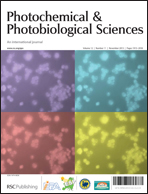Triplet recombination of radical ion pairs: CIDNP effects and DFT calculations on 1,2-dicyanoethylene
Abstract
Radical ion pairs generated by electron transfer from photo-excited aromatic hydrocarbons to maleo- and fumaronitrile (cis- and trans-1,2-dicyanoethylene, 1) undergo back electron transfer from singlet and triplet pairs. The pair energies relative to the reactant ground states and to the triplet state, respectively, determine the competition between the recombination pathways. Cross sections through the potential surfaces of the radical anion and the triplet state of 1 have been examined by density functional theory calculations. The radical anion surface has minima in which the carbon and nitrogen skeleton is essentially planar; the central C–C bond is lengthened (weakened), but the barrier to geometric isomerization is still sizeable (31.2 kcal mol−1). The triplet energy surface has a minimum at a bisected geometry (plus its enantiomer); rotation of the H–C–CN segments of the triplet yields a syn-periplanar and an anti-periplanar point 9.3 kcal mol−1 and 8.2 kcal mol−1 above the minimum, respectively.


 Please wait while we load your content...
Please wait while we load your content...